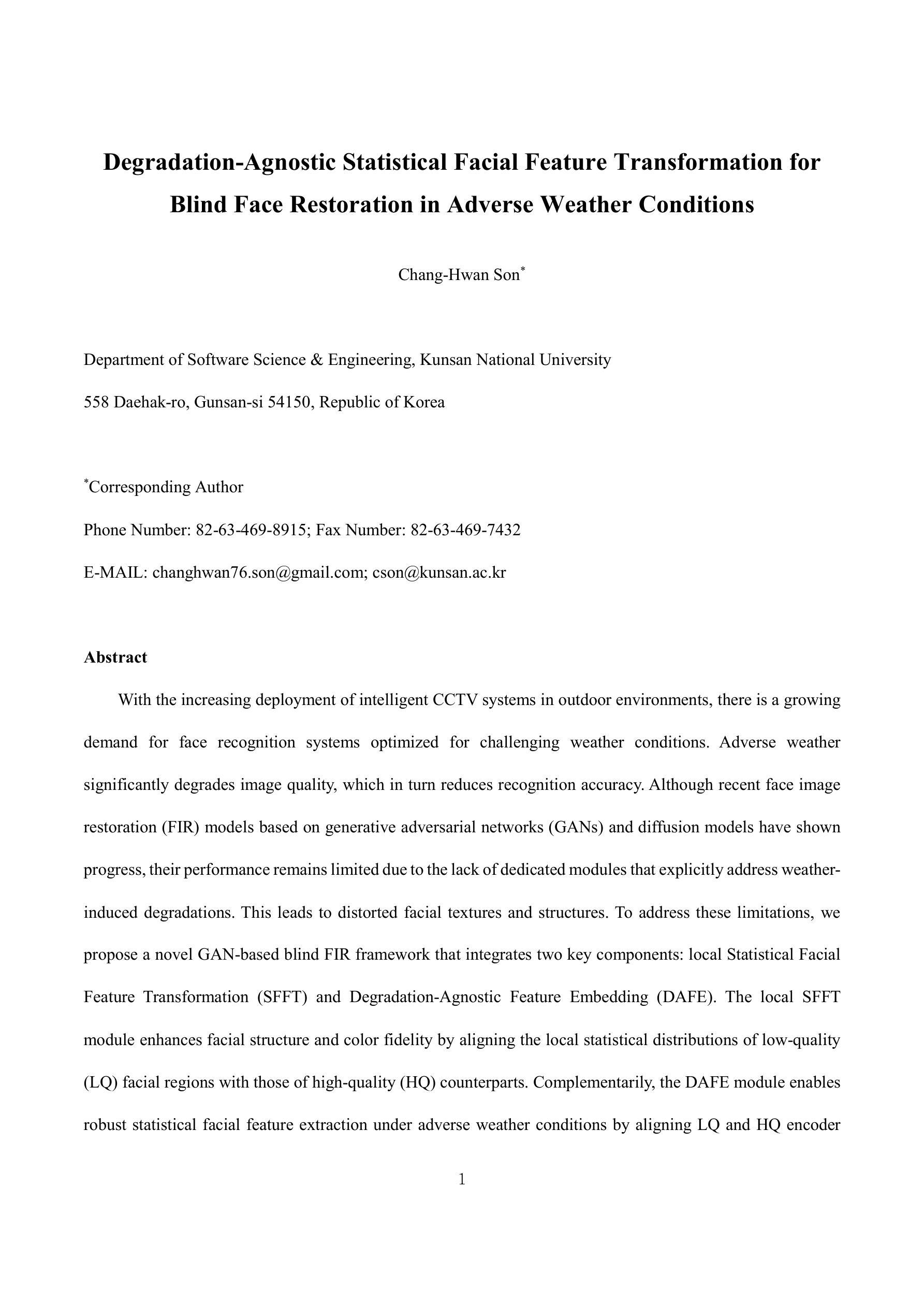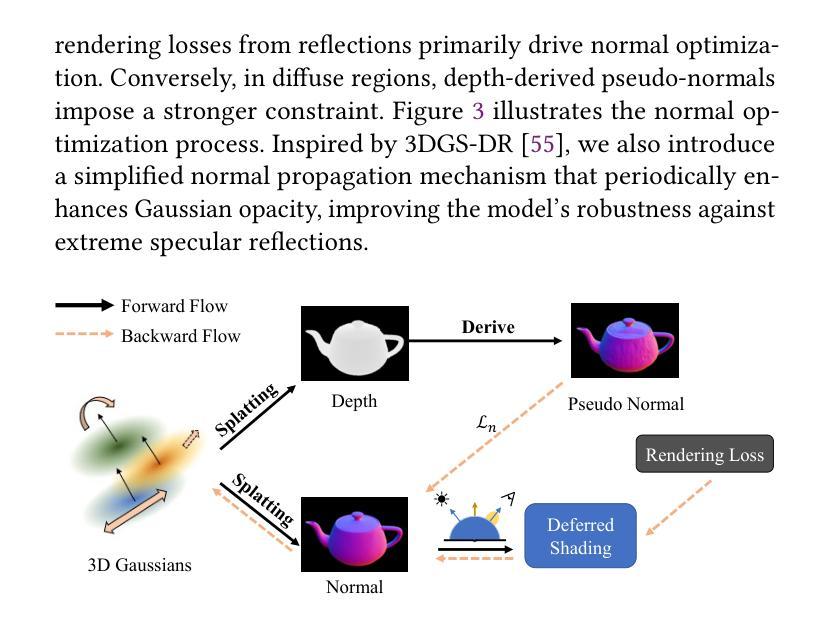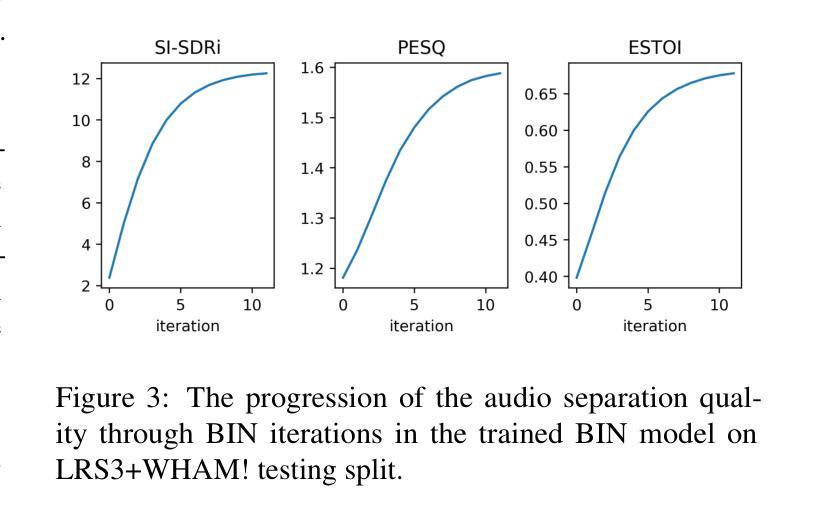⚠️ 以下所有内容总结都来自于 大语言模型的能力,如有错误,仅供参考,谨慎使用
🔴 请注意:千万不要用于严肃的学术场景,只能用于论文阅读前的初筛!
💗 如果您觉得我们的项目对您有帮助 ChatPaperFree ,还请您给我们一些鼓励!⭐️ HuggingFace免费体验
2025-07-12 更新
Degradation-Agnostic Statistical Facial Feature Transformation for Blind Face Restoration in Adverse Weather Conditions
Authors:Chang-Hwan Son
With the increasing deployment of intelligent CCTV systems in outdoor environments, there is a growing demand for face recognition systems optimized for challenging weather conditions. Adverse weather significantly degrades image quality, which in turn reduces recognition accuracy. Although recent face image restoration (FIR) models based on generative adversarial networks (GANs) and diffusion models have shown progress, their performance remains limited due to the lack of dedicated modules that explicitly address weather-induced degradations. This leads to distorted facial textures and structures. To address these limitations, we propose a novel GAN-based blind FIR framework that integrates two key components: local Statistical Facial Feature Transformation (SFFT) and Degradation-Agnostic Feature Embedding (DAFE). The local SFFT module enhances facial structure and color fidelity by aligning the local statistical distributions of low-quality (LQ) facial regions with those of high-quality (HQ) counterparts. Complementarily, the DAFE module enables robust statistical facial feature extraction under adverse weather conditions by aligning LQ and HQ encoder representations, thereby making the restoration process adaptive to severe weather-induced degradations. Experimental results demonstrate that the proposed degradation-agnostic SFFT model outperforms existing state-of-the-art FIR methods based on GAN and diffusion models, particularly in suppressing texture distortions and accurately reconstructing facial structures. Furthermore, both the SFFT and DAFE modules are empirically validated in enhancing structural fidelity and perceptual quality in face restoration under challenging weather scenarios.
随着智能CCTV系统在户外环境中的部署不断增加,对于针对恶劣天气条件优化的面部识别系统的需求也在增长。恶劣天气会严重降低图像质量,进而导致识别准确度下降。尽管最近基于生成对抗网络(GAN)和扩散模型的面部图像恢复(FIR)模型已经取得了一些进展,但由于缺乏专门解决天气引起的退化的模块,其性能仍然受到限制。这会导致面部纹理和结构失真。为了解决这些局限性,我们提出了一种基于GAN的盲FIR框架,该框架包含两个关键组件:局部统计面部特征变换(SFFT)和退化无关特征嵌入(DAFE)。局部SFFT模块通过使低质量(LQ)面部区域的局部统计分布与高质量(HQ)区域的统计分布对齐,增强面部结构和颜色保真度。互补地,DAFE模块通过对齐LQ和HQ编码器表示,使面部特征提取在恶劣天气条件下更加稳健,从而使恢复过程适应于恶劣天气引起的退化。实验结果表明,所提出的退化无关SFFT模型在抑制纹理失真和准确重建面部结构方面优于现有的基于GAN和扩散模型的先进FIR方法。此外,SFFT和DAFE模块在提高结构保真度和感知质量方面都经过了验证,能够在具有挑战性的天气情况下提高面部恢复的恢复效果。
论文及项目相关链接
Summary
针对户外环境中智能监控系统的广泛应用,对面部识别系统提出了在恶劣天气条件下的优化需求。虽然基于生成对抗网络(GAN)和扩散模型的面部图像恢复(FIR)模型已取得进展,但由于缺乏专门应对天气引起的降质的模块,其性能仍然有限。为此,提出一种新型的基于GAN的盲FIR框架,包括局部统计面部特征变换(SFFT)和降质无关特征嵌入(DAFE)两个关键组件。前者提高面部结构和色彩保真度,后者使面部特征提取在恶劣天气下更为稳健。实验证明,该模型在抑制纹理失真和准确重建面部结构方面优于现有先进FIR方法。
Key Takeaways
- 智能监控系统在户外环境中的应用对面部识别系统在恶劣天气下的性能提出了要求。
- 现有基于GAN和扩散模型的面部图像恢复(FIR)模型在应对天气引起的图像降质方面存在局限性。
- 新提出的盲FIR框架包含局部统计面部特征变换(SFFT)和降质无关特征嵌入(DAFE)两个关键组件。
- SFFT模块通过对齐低质量(LQ)面部区域与高质量(HQ)区域的局部统计分布,提高面部结构和色彩保真度。
- DAFE模块通过对齐LQ和HQ编码器表示,使面部特征提取在恶劣天气条件下更为稳健。
- 提出的模型在抑制纹理失真和准确重建面部结构方面表现出优越性能。
点此查看论文截图


